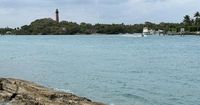The Bureau of Land Management (BLM) has officially kicked off a significant infrastructure project at the Jupiter Inlet Lighthouse Outstanding Natural Area, which aims to enhance the landmark and protect the ecological integrity of its surroundings. The groundbreaking ceremony took place on March 24, 2025, and representatives from the local community, elected officials, and various partners joined in to celebrate this $16 million initiative.
The project primarily focuses on stabilizing the shoreline, providing resilient recreational facilities, and safeguarding the unique resources around the lighthouse. Funded in part by an investment of $8.3 million from the Great American Outdoors Act, this endeavor will incorporate both engineered measures and living shoreline components to combat erosion and minimize sediment entering the Intracoastal Waterway.
The planned construction spans approximately 5 acres and includes crucial installations such as a retaining wall, in-water wave breaks, pilings, and artificial reef structures. Additionally, the project will add shoreline access points and plant upland and tidal vegetation, including mangroves, to further protect and enhance terrestrial and marine habitats.
BLM Acting Eastern States Director Leah Baker emphasized the necessity of this intervention, remarking, "Without intervention, these public lands will continue to lose seven feet of shoreline annually." Baker noted that the BLM and its local and state partners are committed to preserving the shoreline at the Jupiter Inlet Lighthouse Outstanding Natural Area for future generations to enjoy.
Cooperative efforts will see federal funding matched by $7 million in grants from the Florida Inland Navigation District. According to Florida Inland Navigation District Commissioner Austin Burkett, "We are excited to partner with the Bureau of Land Management in this effort. This critical project will aid in protecting the navigability of the Intracoastal Waterway around the Jupiter Lighthouse and preserve shoreline access for boaters and other recreationalists in perpetuity."
enditionAs the project progresses, visitors can look forward to improved access to educational facilities, enhanced shoreline, and the beautiful Loxahatchee River. New recreational features will include an upgraded kayak launch and dock, ADA-compliant walkways, improved safety measures for the marine education and snorkeling area, and durable in-water structures designed to withstand the harsh effects of wave action, tides, and storms.
This shoreline stabilization project complements earlier enhancement efforts undertaken in collaboration with the Jupiter Inlet District, Loxahatchee River District, and the Jupiter Inlet Lighthouse & Museum. Executive Director of the Loxahatchee River Historical Society, Katrina Heller, expressed optimism for continued partnerships, stating, "This action will revitalize our public lands and safeguard historical resources and recreational opportunities in the area for generations to come."
In 2008, Congress designated the Jupiter Inlet Lighthouse Outstanding Natural Area, which spans approximately 120 acres, to showcase the ecological and cultural significance of the area. The site attracts over 150,000 visitors each year, serving as a vital space for public recreation, education, and conservation initiatives aimed at preserving its history and natural beauty.
In a related context, the Loxahatchee River Historical Society has raised concerns about potential impacts on the Jupiter Lighthouse, stemming from federal restructuring plans and possible land sales by the government. In response, the society launched a new website aimed at educating the public about the ownership situation of the lands surrounding the lighthouse and advocating for its protection.
Katrina Heller, the society’s executive director, reassured residents that the land underneath the lighthouse is not currently at risk. “We’re not very fearful that it will be sold,” she noted. “We just want to make sure that everyone is aware who we are, what this land does and how it’s protected.”
To foster public awareness, the society provides sample letters for residents to send to Congressman Brian Mast, urging him to safeguard sites like the lighthouse. Heller points out that while nonprofits like theirs cannot lobby, these efforts are purely educational.
Peter DeWitt, who manages the lighthouse area for the BLM, corroborated the society’s sentiment, saying he is unaware of any initiatives to sell the lighthouse or the surrounding land, which is protected under a Congressional Act from 2008. He confirmed, "It would take an act of Congress to undo the protections for the outstanding natural area."
In light of the ongoing improvements and community efforts aimed at preserving the Jupiter Inlet Lighthouse and its surrounding area, the future looks promising for residents and visitors alike. As these developments unfold, community engagement remains a crucial component, ensuring that the ecological and cultural significance of the lighthouse is maintained for generations.





